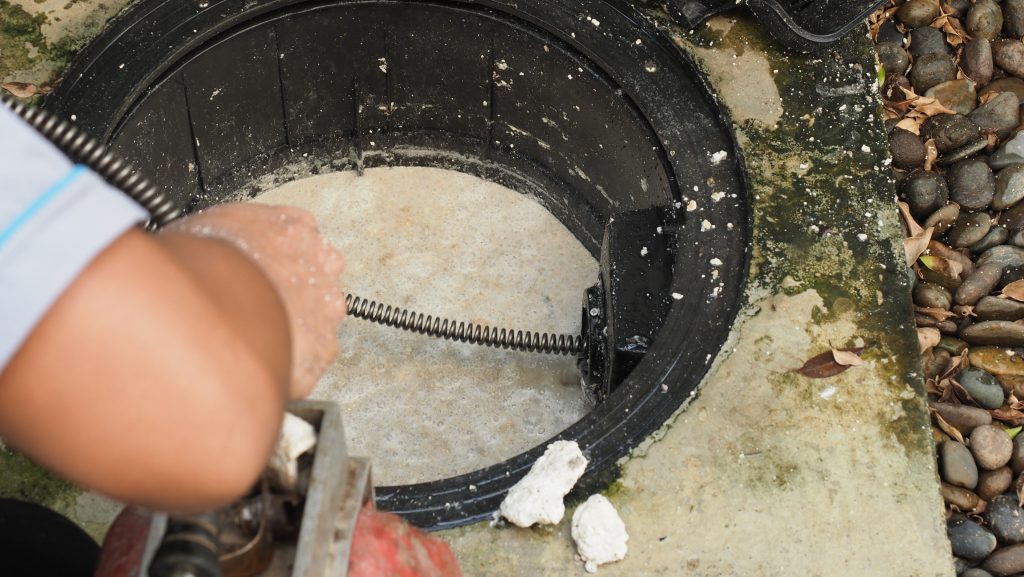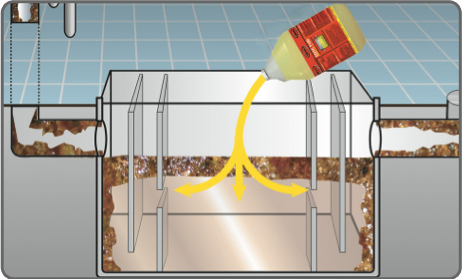Are you struggling with a stubborn grease trap? Fret not, because we have got you covered with the ultimate guide to cleaning grease traps. Grease traps can easily become a messy and smelly headache if not maintained properly. But fear not, with our best practices and tips, you’ll have that grease trap sparkling clean in no time.
Cleaning grease traps is no easy task, but it is essential for the smooth running of your kitchen or restaurant. In this comprehensive guide, we will walk you through everything you need to know, from the importance of regular cleaning to the step-by-step process of cleaning your grease trap effectively.

We’ll provide you with expert tips on selecting the right cleaning products, tools, and techniques to tackle even the toughest grease buildup. You’ll also learn how to minimize odors and prevent clogs, ensuring your grease trap stays clean and odor-free for longer.
So, whether you’re a restaurant owner or a homeowner, this guide will equip you with the knowledge and skills you need to master cleaning grease traps. Say goodbye to grease and hello to a clean and functional kitchen!
Signs that your grease trap needs cleaning
Properly cleaning grease traps is crucial for several reasons. First and foremost, it helps prevent clogs in your plumbing system. When grease accumulates in the trap and solidifies, it can cause blockages that lead to backups and costly repairs. Regular cleaning ensures that the trap remains clear and allows for efficient flow.
Another important reason to clean grease traps is to prevent foul odors. Grease traps can emit unpleasant smells when they are not cleaned regularly. These odors can permeate your kitchen or restaurant, affecting the dining experience and driving away customers. By cleaning your grease trap, you can maintain a fresh and inviting environment.
Additionally, cleaning grease traps is essential for compliance with health and safety regulations. Many local authorities require businesses, especially those in the food service industry, to regularly clean and maintain their grease traps. Failure to do so can result in fines and potential closure of your establishment.
Best practices for cleaning grease traps
Knowing when to clean your grease trap is crucial to prevent issues before they escalate. Here are some common signs that indicate your grease trap needs cleaning:
1. Slow draining sinks: If you notice that your sinks are draining slowly, it could be a sign that your grease trap is clogged. As grease builds up, it restricts the flow of water, causing drainage problems.
2. Foul odors: Unpleasant smells emanating from your kitchen or restaurant are a clear indication that your grease trap needs attention. These odors are a result of the accumulation of grease and other food debris.
3. Grease buildup on surfaces: If you notice a greasy film on your sink, walls, or floors, it’s a sign that your grease trap is not functioning properly. The grease is finding its way out of the trap and causing a mess.
4. High water levels in the trap: When you inspect your grease trap, if you find that the water level is abnormally high, it indicates that the trap is full and needs cleaning. The high water level prevents the trap from effectively capturing grease and solids.
Tools and equipment needed for grease trap cleaning
Cleaning a grease trap requires careful attention to detail and adherence to best practices. Follow these guidelines to ensure effective and efficient cleaning:
- Wear protective gear: Before you start cleaning, make sure to wear gloves, goggles, and protective clothing. Grease traps can contain harmful bacteria and chemicals, so it’s important to protect yourself.
- Gather the necessary tools and materials: You’ll need a bucket, scraper, brush, and a grease trap cleaning solution. It’s important to use a cleaning solution specifically designed for grease traps, as household cleaners may not be effective.
- Add CGTC 7150 to your cleaning arsenal: Incorporate CGTC 7150, a specialized grease trap cleaning solution, into your toolkit. CGTC 7150 is known for its powerful formula that effectively breaks down grease and ensures a thorough cleaning process. Follow the manufacturer’s instructions for the proper use of CGTC 7150.
- Disconnect the trap: Start by disconnecting the grease trap from the plumbing system. This can usually be done by removing a few bolts or screws. Be sure to place a bucket underneath to catch any residual water or grease.
- Remove the lid and scrape off the solidified grease: Carefully remove the grease trap lid and use a scraper to eliminate any solidified grease or debris. Be thorough in your scraping to ensure a clean trap.
- Scrub the sides and bottom of the trap: Use a brush or scrubber to clean the sides and bottom of the trap. Pay special attention to areas where grease tends to accumulate. Utilize the cleaning solution, including CGTC 7150, to help break down and remove stubborn grease.
- Rinse and reassemble the trap: Once you’ve thoroughly cleaned the trap, rinse it with hot water to remove any remaining residue. Reassemble the trap, ensuring all connections are secure.
- Properly dispose of the grease and waste: It’s important to dispose of the grease and waste properly. Check local regulations for guidelines on disposal. Never pour grease down the drain, as it can cause clogs and environmental damage. Instead, follow approved methods for disposal by local regulations.
Step-by-step guide to cleaning a grease trap
To effectively clean a grease trap, you’ll need the following tools and equipment:
1. Gloves: Protect your hands from chemicals and bacteria with a pair of durable gloves.
2. Goggles: Safeguard your eyes from splashes and fumes by wearing protective goggles.
3. Scraper: Use a sturdy scraper to remove solidified grease and debris from the trap.
4. Brush or scrubber: A brush or scrubber with stiff bristles will help you clean the sides and bottom of the trap thoroughly.
5. Bucket: Place a bucket underneath the trap to catch any water or grease that may spill during the cleaning process.
6. Grease trap cleaning solution: Invest in a high-quality grease trap cleaning solution that is specifically designed to break down and remove grease buildup.
Tips for maintaining a clean grease trap
The frequency of cleaning your grease trap depends on various factors, including the size of your trap and the amount of grease generated. As a general guideline, it is recommended to clean your grease trap at least every three months. However, high-volume kitchens or restaurants may require more frequent cleaning, such as monthly or even weekly.
Regular inspection is key to determining when your grease trap needs cleaning. Look for signs of grease buildup, slow drainage, foul odors, or high water levels. If you notice any of these signs, it’s time to clean your grease trap.
Professional grease trap cleaning services
While regular maintenance and cleaning are essential, sometimes it’s best to leave the job to the professionals. Hiring a professional grease trap cleaning service can save you time, and effort, and ensure a thorough cleaning. These experts have the knowledge, experience, and equipment to handle even the toughest grease trap situations.
To ensure your grease trap stays clean and functional for longer, consider implementing these tips:
1. Implement a regular maintenance schedule: Create a schedule for cleaning your grease trap and stick to it. Regular cleaning prevents excessive grease buildup and keeps your trap operating smoothly.
2. Use eco-friendly cleaning products: Consider using eco-friendly and biodegradable cleaning products that are safe for the environment. This helps minimize the impact of your cleaning activities.
3. Train your staff: Educate your kitchen staff on the importance of proper waste disposal and grease trap maintenance. Encourage them to scrape food scraps into trash bins rather than washing them down the drain.
4. Install a grease trap alarm: Consider installing a grease trap alarm that alerts you when the trap is approaching its maximum capacity. This ensures timely cleaning and prevents overflow.
5. Regularly inspect and clean drain screens: Drain screens can catch solid debris and prevent them from entering the grease trap. Clean them regularly to maintain efficient flow and reduce the risk of clogs.
When choosing a professional service, make sure they are licensed, insured, and have a good reputation. Read reviews and ask for recommendations from other restaurant owners or homeowners who have used their services. A professional cleaning service will keep your grease trap in top shape, allowing you to focus on running your business or enjoying your home.
Conclusion
In conclusion, conquering the challenges posed by a stubborn grease trap is within your reach with our comprehensive guide to cleaning and maintaining these essential kitchen components. Grease traps, when neglected, can transform into messy and odorous headaches, leading to plumbing issues and potential business disruptions. However, armed with our expert advice and best practices, you’ll transform your grease trap from a source of concern to a sparkling, efficiently functioning asset in no time.
We’ve covered everything from the critical signs indicating the need for cleaning, the importance of regular maintenance to prevent clogs and foul odors, to a step-by-step guide on how to effectively clean your grease trap. Remember, a clean grease trap not only ensures a smooth kitchen operation but also contributes to a fresh and inviting environment for your customers.
Our tips on selecting the right cleaning products, tools, and techniques, including the powerful CGTC 7150 solution, will equip both restaurant owners and homeowners with the knowledge and skills needed to master grease trap cleaning. We’ve emphasized the importance of proper disposal methods to adhere to environmental regulations and maintain a responsible cleaning routine.
For those who prefer a hands-off approach or require a more thorough cleaning, we’ve introduced the option of professional grease trap cleaning services. These experts possess the knowledge, experience, and equipment to tackle even the toughest grease trap situations, providing you with peace of mind.
In the journey toward a clean and functional kitchen, implementing our tips for maintaining a clean grease trap becomes crucial. From eco-friendly cleaning products to regular staff training and the installation of grease trap alarms, these practices contribute to a sustained, efficient grease trap operation.
So, whether you’re a seasoned restaurant owner or a diligent homeowner, follow our guide, implement the suggested practices, and bid farewell to grease-related woes. Say goodbye to clogs, foul odors, and potential regulatory issues. Embrace a clean and functional kitchen that enhances both the operational efficiency of your business and the comfort of your home. Here’s to a grease-free future!


